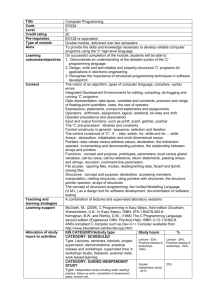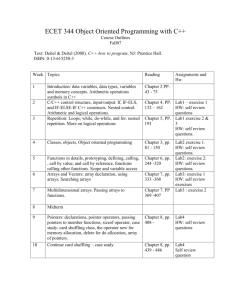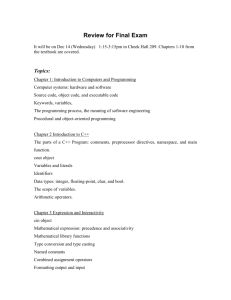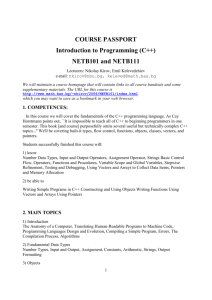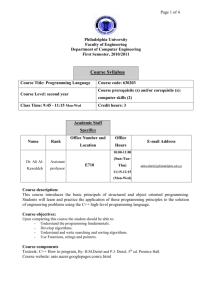Arrays and Pointers. Lecture Plan.
advertisement
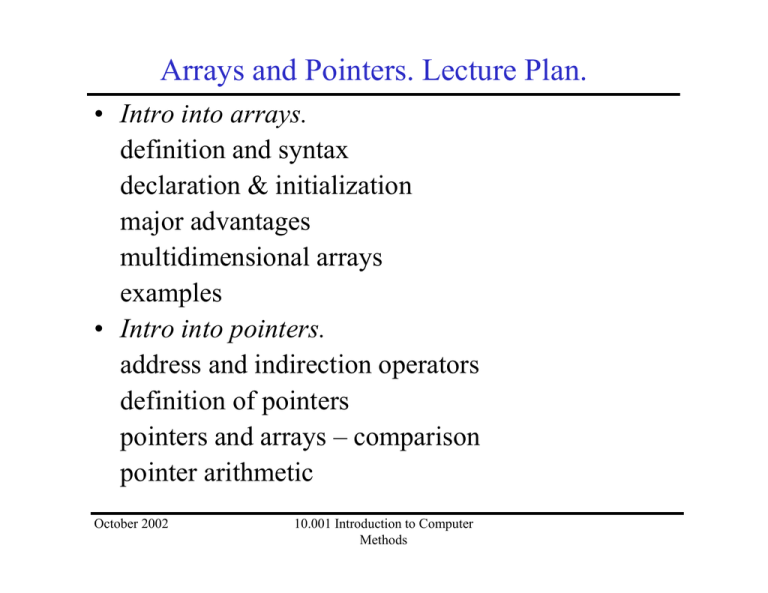
Arrays and Pointers. Lecture Plan.
• Intro into arrays.
definition and syntax
declaration & initialization
major advantages
multidimensional arrays
examples
• Intro into pointers.
address and indirection operators
definition of pointers
pointers and arrays – comparison
pointer arithmetic
October 2002
10.001 Introduction to Computer
Methods
Arrays and Pointers
Array is a group of elements that share a common
name, and that are different from one another by
their positions within the array.
C syntax: x[1]=3.14; Declaration: int x[5];
x[2]=5.2;
x[3]=6347;
type name size
Array index
October 2002
Sets aside memory
for the array
10.001 Introduction to Computer
Methods
Arrays and Pointers
Initialization:
int grade[]={100,99,85};
int grade[3]={100,99,85};
int grade[100]={1,3,5,7};
– grade[4]-grade[99] will be zeros.
grade[36] = 87;
Multidimensionality:
Scalar variable
Vector variable (1D)
Matrix variable (2D)
October 2002
a
a0, a1, a2,...
a00, a01,a02,...
a10,a11,a12,...
a20,a21,a22,...
...
10.001 Introduction to Computer
Methods
Arrays and Pointers
Declaration: int L=100, M=100, N=100;
float a[L][M][N];
Initialization: alpha[2][2]={1,2,3,4};
alpha[2][2]={{1,2},{3,3}};
alpha[0][1]=3;
alpha[1][1]=2;
NB: Array size is fixed at declaration.
#define L 100
#define M 100
#define N 100
...
int a[L][M][N]
October 2002
10.001 Introduction to Computer
Methods
Arrays and Pointers
NB: In C numbers of array elements start form zero:
x[0], x[1], x[2], x[3], x[4]. There is no x[5].
NB: If x[5] is accessed, no error will result!
Utility: simplify programming of repetitive operations
improve clarity
improve modularity
improve flexibility
October 2002
10.001 Introduction to Computer
Methods
Arrays and Pointers
Example: a program to compute the class average of the midterm.
Scalar form:
Vector (array) form:
int main(void){
float average;
int sum=0,grade1,
grade2,..;
scanf(“%d”,&grade1);
scanf(“%d”,&grade2);
...
sum += grade1;
sum += grade2;
...
average = sum/95.0;
}
int main(void){
float average;
int i,n,sum=0,grade[100];
scanf(“%d”,&n);
for(i=0;i<n,&n;i++){
scanf(“%d”,&grade[i]);
sum += grade[i];
}
...
average = (float)sum/n;
}
October 2002
10.001 Introduction to Computer
Methods
Arrays and Pointers
Example: Integration using Composite Trapezoid Rule
b
I = ∫ f ( x) dx
a
Continuous function f(x), x belongs to [a,b]
a set of discrete values f(xi), xi belong to [a,b].
h
f (a ) + f (b) N −1
+ ∑ f ( xi )
I = ∑ [ f ( xi −1 ) + f ( xi )] = h
2
i =1 2
i =1
N
October 2002
10.001 Introduction to Computer
Methods
Arrays and Pointers
Given a function y=f(x) to integrate
form x=a to x=b:
int main(void) {
...
h=(b-a)/n;
integral =0.5*(func(a)+func(b));
for(i=1;i<n;i++)
integral += func(a+i*h);
integral *=h;
...
return(0);
}
October 2002
10.001 Introduction to Computer
Methods
Arrays and Pointers
Given discrete data yi = f(xi) integrate form x=a to x=b:
int main(void) {
...
for (i=0; i<=n; i++)
scanf(“%f”,&y[i]); /*reading f(xi)*/
integral =0.5*(y[0]+y[n]);
for(i=1; i<n; i++){
scanf(“%f”,&y);
/*summing f(x[i])*/
integral += y;
}
scanf(“%f”, &a)
scanf(“%f”, &b)
integral *= (b-a)/n;
...
return(0);
}
October 2002
10.001 Introduction to Computer
Methods
Arrays and Pointers
Calculating the average. Version 1. /*No arrays.*/
#include <stdio.h>
int main(void)
{
float ave;
int sum=0;
int data1, data2, data3;
scanf(“%d”, &data1);
scanf(“%d”, &data2);
scanf(“%d”, &data3);
sum == data1;
• inefficient coding
sum += data2;
• only works for a fixed
sum += data3;
ave = sum/3.0;
number of data points
...
}
October 2002
10.001 Introduction to Computer
Methods
Arrays and Pointers
Calculating the average. Version 2.
/* no arrays, scalar “for” loop */
#include <stdio.h>
int main(void)
{
float ave;
int i, n, datai, sum=0;
scanf(“%d”, &n);
for (i=0;i<n;i++){
scanf(“%d”, &datai);
sum += datai;
}
ave = (float) sum/n;
...
}
October 2002
10.001 Introduction to Computer
Methods
Arrays and Pointers
Calculating the average. Version 3. /* with arrays */
#include <stdio.h>
#include <math.h>
#define NMAX 100
int main(void)
{
float ave;
int i, n, data[NMAX], sum=0;
scanf(“%d”, &n);
if(n>NMAX) printf(“number of pts > NMAX);
for (i=0; i<n; i++)
scanf(“%d”, &data[i]);
sum += data[i];
}
ave = float(sum)/n; • array size is fixed at declaration
• use #define to have some flexibility
...
}
October 2002
10.001 Introduction to Computer
Methods
Arrays, Summing up
• The name identifies the location in memory, big
enough to store the whole array.
• a[k] refers to the k-th element of the array, the
indexing starting from 0.
• The memory allocation happens when the array is
declared: use # to set the dimensions.
• Advantages: clear and compact coding, better
modularity, take advantage of loops for repetitive
operations.
October 2002
10.001 Introduction to Computer
Methods
Arrays and Pointers
Intro into pointers.
& - address operator, unary, right to left precedence
v – variable
&v – location (address) of v in
the memory
The special type of variable to operate with the address is
needed: POINTER
pv = &v;
Identifier
Memory address
Value
October 2002
v
1776
5
pv
1997
1776
10.001 Introduction to Computer
Methods
Arrays and Pointers
Declaration: int *p;
p – pointer to integer variable.
Value range: zero or NULL address and a set of positive
integers.
Assignment: p=0; p=NULL; p=&i; p=(int *)1776;
address of i
cast as “pointer to int”
Indirection (dereferencing) operator * - “inverse” to &.
Gives the value of the variable pointed to by the pointer.
p = &i;
i = *p; We can access any variable, if
know the variable’s address!
&i = p; illegal, addresses are allocated by declarations.
p = &3; p = &(i+j); illegal: constants and
expressions do not have addresses.
October 2002
10.001 Introduction to Computer
Methods
Arrays and Pointers
Relationship between arrays and pointers:
• Array name is a pointer constant, it’s value is the
address of the first element of the array.
• Pointers can be subscribed
a[i] = *(a + i)
a – address of a[0]
(base address or the array)
a[i] = *(p + i) points to i-th element of
the array
NB: a is a constant pointer, a=p, ++a,
are illegal.
October 2002
10.001 Introduction to Computer
Methods
&a
Arrays and Pointers
Pointer arithmetic is equivalent to array indexing:
p = a + 1
p = &a[1]
p = a + m
p = &a[m]
Summing the array using pointers:
for (p = a; p < &a[N]; ++p)
sum += *p;
or
for (i = 0; i < N; ++i)
sum += *(a + i);
October 2002
10.001 Introduction to Computer
Methods
Arrays and Pointers
Pointer arithmetic:
p + 1 ++p
p + i
p += i
However, pointers and numbers are not quite the same:
double
a[2], *p, *q;
p = a;
q = p + 1;
printf(“%d\n”, q – p);
/* 1 is printed */
printf(“%d\n”,(int) q – (int) p);
/* 8 is printed */
The difference in terms of array elements is 1, but the
difference in memory locations is 8!
October 2002
10.001 Introduction to Computer
Methods
Arrays and Pointers
Arrays and pointers as function arguments:
“call by value”
–
“call by reference”
•Variables themselves
are passed as function
arguments.
•The variables are
copied to be used
by the function.
•Variables are directly
accessed by the function.
•Dealing directly with
variables, which are
are not changed in
calling environment.
October 2002
•Pointers are used in the
parameter list: addresses of
variables are passed as
arguments.
•The variables may be
changed inside the function
and returned.
10.001 Introduction to Computer
Methods
Arrays and Pointers
Passing arrays to functions:
As individual scalars: x=sum(grade[k],grade[k+1]);
prototype:
int sum(x,y)
{
int x, y;
...
Using pointers:
x = sum(grade,n)
prototype:
int sum(int *grade, int n);
{
int res, *p;
res =0;
for (p=grade;p<&grade[N];++p)
sum += *p;
return(res);
}
October 2002
10.001 Introduction to Computer
Methods
Arrays and Pointers
The function swaps two variables, using “call by
reference”.
void swap(int *p, int *q)
{
int tmp;
tmp = *p;
*p = *q;
*q = tmp;
}
October 2002
10.001 Introduction to Computer
Methods
Arrays and Pointers
Checking how “swap” works:
#include <stdio.h>
void swap(int *, int *)
{
int i = 3, j = 5;
swap(&i, &j);
printf(“%d %d\n”, i, j);
return 0;
}
/* 5 3 is printed */
October 2002
10.001 Introduction to Computer
Methods
Arrays and Pointers
Pointer arithmetic summed up:
1. Assignment: ptr = &a;
2. Value finding: *ptr = a;
3. Taking pointer address: &ptr – address of ptr
in the memory.
4. Addition/subtratction: ptr2 = ptr1 +1;
ptr2-ptr2;
5. Increment: ptr1++
ptr1 + 1
NB Increment does not work for pointer constants.
6. Indexing – like arrays: ptr[i] = a[i];
October 2002
10.001 Introduction to Computer
Methods
